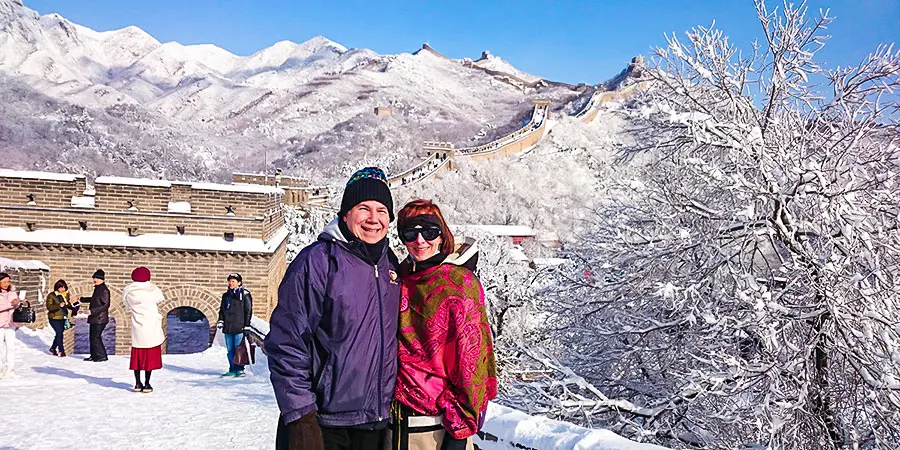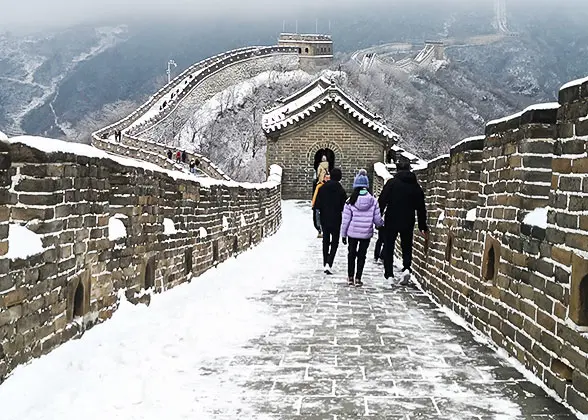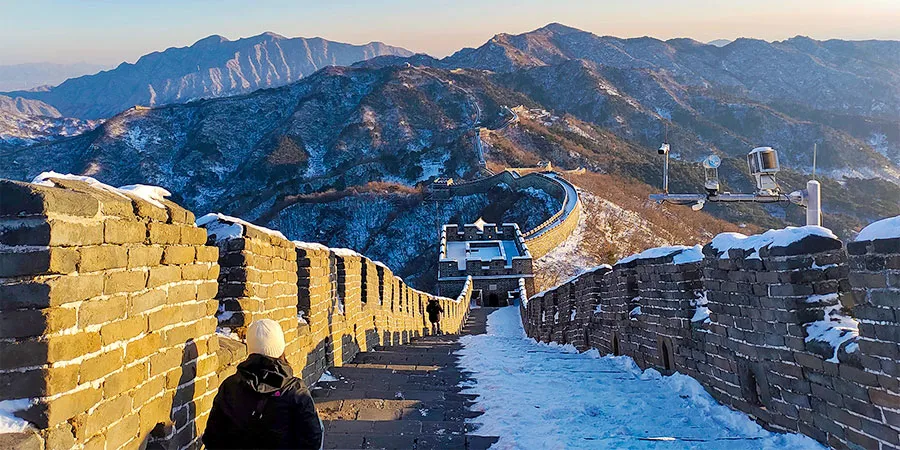8 Guidelines for Travel to Great Wall of China in Winter
 |
| Visit Great Wall of China in Winter |
1. Know the Great Wall Weather in Winter - Cold, Below 0℃ (32℉)
December to February is the winter season at the Great Wall. During this period, the temperature in the Great Wall area is usually below 0℃ (32℉), especially in the coldest month of January, when the lowest temperature can reach -16℃ (3℉). When accompanied by wind, the cold becomes even more bone-chilling. Snowfall is possible in each of these months, with an average of two snow events per month. If you’re visiting specifically for the Great Wall’s snow scenery, be sure to check the weather forecast in advance and select a sunny, windless day following a snowfall.
![]() Great Wall of China Weather in December: Cold and dry, with occasional snow; average temperature: -9℃ to 3℃ (16℉ to 37℉)
Great Wall of China Weather in December: Cold and dry, with occasional snow; average temperature: -9℃ to 3℃ (16℉ to 37℉)
![]() Great Wall of China Weather in January: The coldest month, with strong winds; average temperature: -12℃ to 1℃ (10℉ to 34℉)
Great Wall of China Weather in January: The coldest month, with strong winds; average temperature: -12℃ to 1℃ (10℉ to 34℉)
![]() Great Wall of China Weather in February: Cold, sunny, and dry; average temperature: -10℃ to 2℃ (14℉ to 36℉)
Great Wall of China Weather in February: Cold, sunny, and dry; average temperature: -10℃ to 2℃ (14℉ to 36℉)
2. Learn about the Great Wall’s Winter Opening Hours
| Sections | Opening Hours |
|---|---|
| Badaling | 7:30 - 17:00, last admission at 16:00 |
| Mutianyu | 08:00 - 17:30 |
| Simatai | Daytime: 9:00 - 17:00, last admission at 16:10 Nighttime: 17:30 - 20:10 |
| Jinshanling | 06:00 - 17:00, last admission at 16:00 |
| Juyongguan | 8:30 - 17:00, last admission at 16:30 |
| Gubeikou | 08:30 - 16:30 |
3. Select the Proper Section
 |
| Mutianyu Covered by Pure Snow |
Badaling, Mutianyu, and Simatai are highly recommended for winter visits to the Great Wall. First, all three sections are equipped with cable cars, enabling tourists to reach the summit and descend quickly without prolonged exposure to the cold. Second, these sections boast the most spectacular snow scenery. What’s more, there is a ski resort near the Badaling Great Wall, and at the foot of Simatai lies Gubei Water Town, which offers hot spring services - both can be easily added to your itinerary to enhance your travel experience.
You may like:
Which Section of Great Wall to Visit?
4. Pick the Optimal Time of Day
The best window to visit the Great Wall in winter is from 11:00 to 15:30. The sunlight during this period helps alleviate some of the cold, and the light around 15:00 is also ideal for capturing great photos.
 |
| Soft sunlight on the Great Wall |
Winter sunrises occur around 7:00 and sunsets around 17:00. It is crucial to avoid visiting the Great Wall before sunrise or after sunset, as temperatures during these times often drop below -10℃, making conditions extremely harsh.
Additionally, the New Year’s Day holiday (January 1st to 3rd) brings a short-lived surge in tourist numbers. It is advisable to avoid this period - after all, waiting in long queues in freezing weather is far from an enjoyable experience.
5. Pack Appropriately: Prioritize Warmth
- Clothes: Thermal base layers, sweaters, and thick, windproof down jackets
- Pants: Thermal long johns and thick, windproof trousers
- Shoes: Fleece-lined hiking boots
- Others: Gloves, scarves, hats, masks, heat packs, and a thermos of hot water
6. Hike with Caution - Especially on Snowy Days
 |
| Slippery sections of the Great Wall |
Winter visitors often wear bulky clothing, and certain sections of the Great Wall have relatively high steps. As such, always pay close attention to your footing and ensure each step is secure. Furthermore, the Great Wall may see snowfall in winter, and after snow, the ground can turn icy, making walking particularly tricky. Be sure to hold onto the handrails and move at a slow, steady pace.
7. Avoid Hiking the “Wild Great Wall” in Winter
Adventure-seeking tourists may be tempted to hike the original, steep sections of the Wild Great Wall, but winter is by no means a suitable time to do so. For one, these wild sections lack clear signage; if you get lost, the nighttime cold is unbearable for most people. Secondly, snow on these sections is not cleared, meaning you won’t be able to spot loose bricks and stones hidden beneath the snow - significantly increasing the risk of falls. For your safety, please refrain from exploring the Wild Great Wall in winter.
8. Travel in Groups
It is advisable to visit the Great Wall in winter with companions, as they can provide immediate assistance in case of emergencies such as hypothermia or falls.
Recommended Tours
![]() Further Reading:
Further Reading:
- Why should I visit the Great Wall of China? - Top 10 Reasons
- How to Visit the Great Wall of China
- How much does it cost to visit the Great Wall of China?
- 10 Insider Tips for Great Wall Travel - Dos and Don’ts
- Camping on the Great Wall of China
- Best Time to Visit Great Wall of China
- 6 Best Places to See Great Wall of China
- 8 Unusual Things to Do at the Great Wall of China



